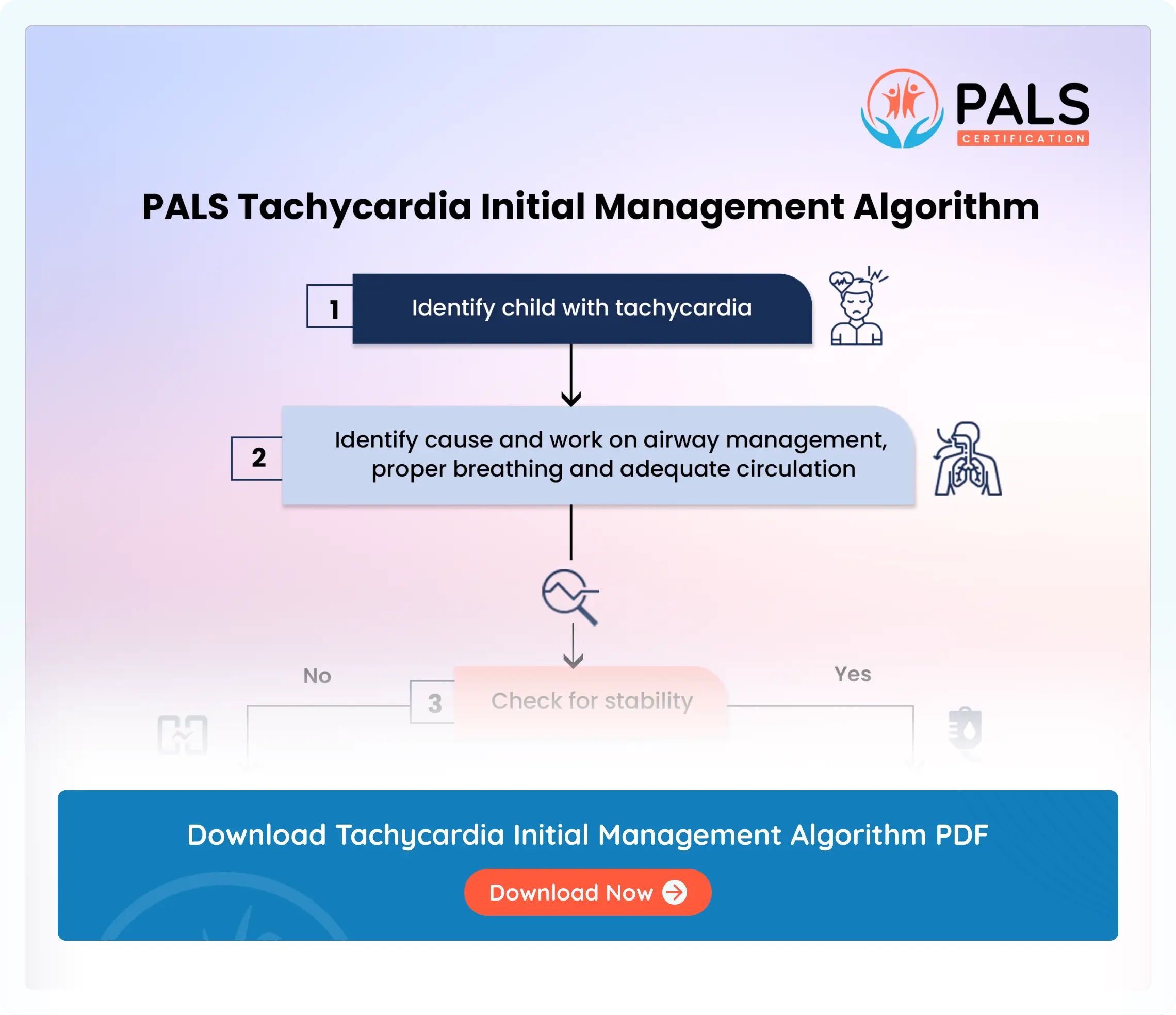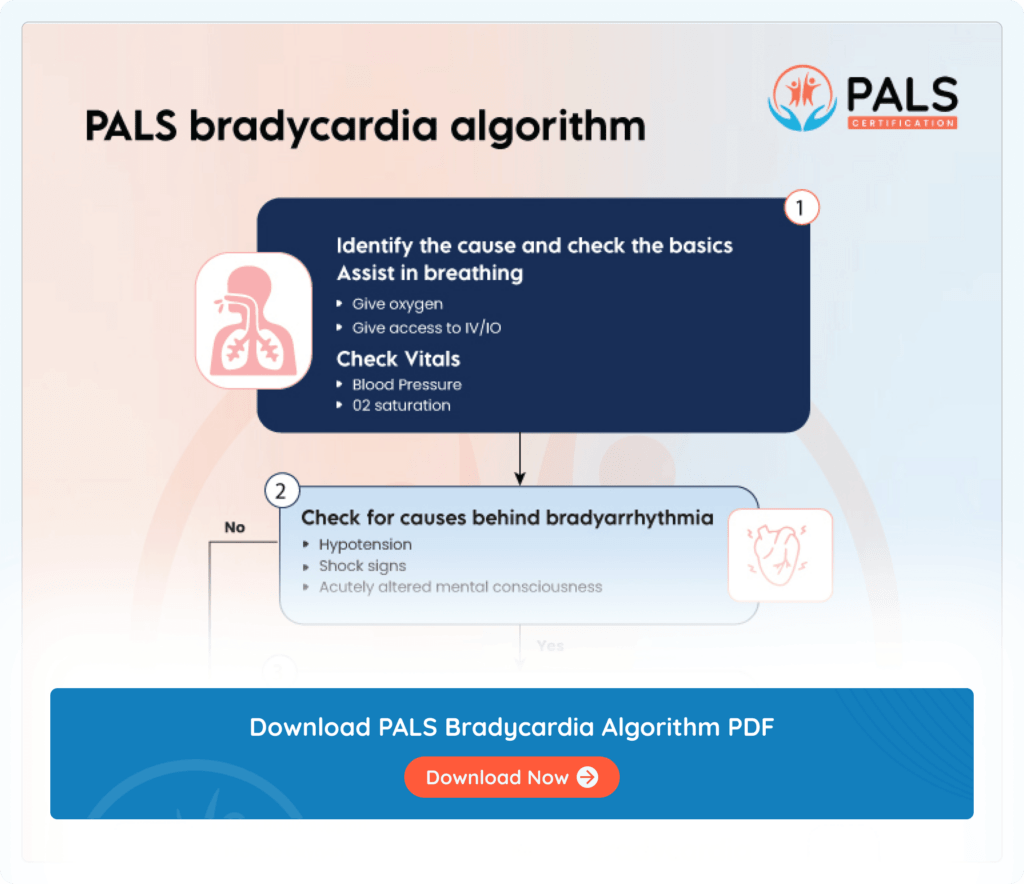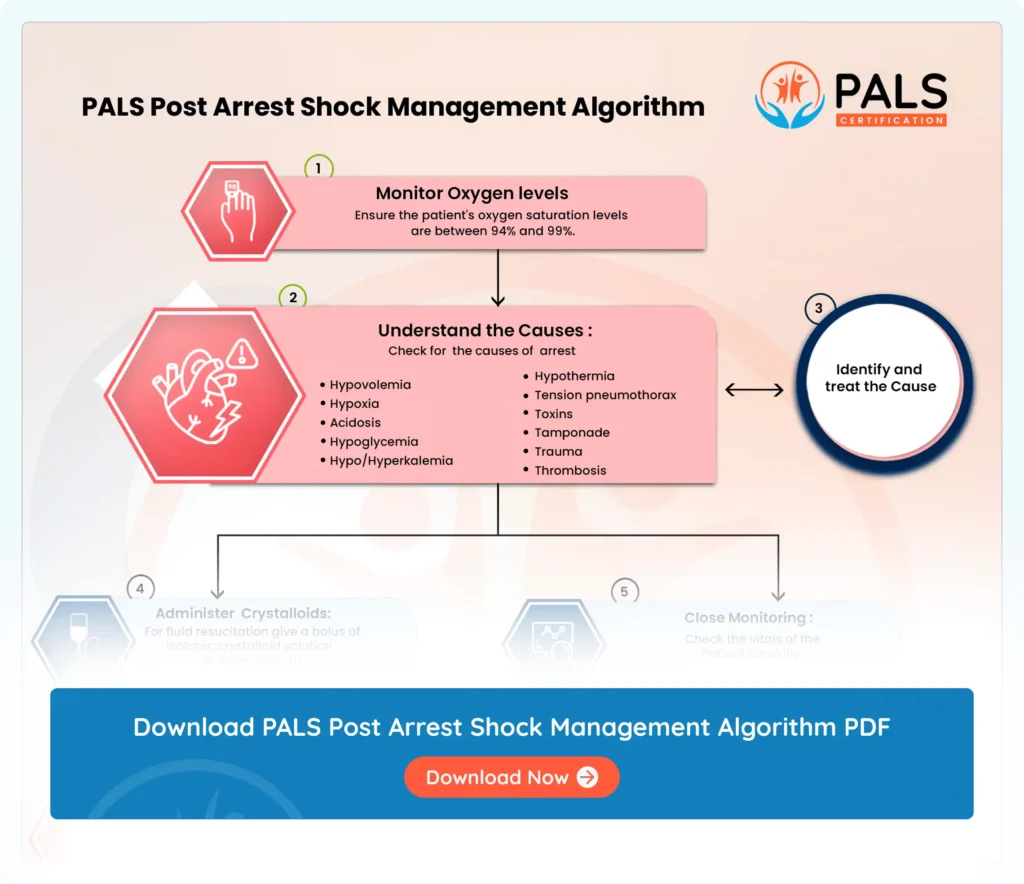- 4.0 CE Credit Hours
- For Pediatric Responders
- Includes Videos, Megacode Scenarios, Practice Tests & More
- FREE BLS Included
The PALS (Pediatric Advanced Life Support) Tachycardia Initial Management Algorithm provides a systematic approach for healthcare providers to assess and manage pediatric patients with tachycardia. It involves evaluating the patient’s clinical condition, determining the presence of signs of poor perfusion, and categorizing the tachycardia as narrow or wide complex.
Based on the assessment findings, interventions such as vagal maneuvers, adenosine administration, synchronized cardioversion, or expert consultation may be recommended to stabilize the patient and restore normal heart rhythm. The below algorithm ensures timely and appropriate management of pediatric tachycardia to optimize patient outcomes.

Online PALS certification and recertification
- Compliant with ECC and OSHA guidelines
- Nationally accepted course
- Available anytime, anywhere
- Earn CE credit hours
$199.00

Explanation of the Flowchart
- Scene Assessment: Identifying the onset of tachycardia marks the first step in helping a child.
- Early Management: The first step is to check for airway management for any obstruction. You should also check for breathing and deliver chest compressions if needed.
- Check for Stability: Once done, you must check if the patient is stable.
- Cardioversion: If you find the patient unstable, deliver cardioversion
- Perfusion Check: If the patient is stable, you must check for adequate perfusion.
- PALS Tachycardia Poor Perfusion Algorithm: If perfusion is inadequate, you need to follow PALS Tachycardia Poor Perfusion Algorithm.
- QRS: If you find adequate perfusion, Check QRS
- PALS Narrow QRS Tachycardia Perfusion Algorithm: If QRS is narrow, you must follow the PALS Narrow QRS Tachycardia Perfusion Algorithm
- PALS Wide QRS Tachycardia Perfusion Algorithm: If you find the QRS to be wide, follow the PALS Wide QRS Tachycardia perfusion Algorithm
Key Highlights
- Heart Range
-
**These ranges are general guidelines, and individual variations may occur. Consult a healthcare provider for specific concerns about your child’s heart rate
- Tachycardia: Pediatric tachycardia refers to an abnormally fast heart rate in children. Tachycardia is typically defined as a heart rate greater than the normal range for a child’s age, which is generally over 100 beats per minute. Pediatric tachycardia can occur for various reasons, including fever, dehydration, stress, anemia, or underlying heart conditions
- ABC Management Technique: In managing tachycardia, following the ABC approach is essential:
- Airway: Ensure that the child’s airway is clear and open. Clear any obstructions, such as foreign objects or fluids, to maintain proper airflow to the lungs.
- Breathing: Assess the child’s breathing pattern and ensure adequate ventilation. If the child is breathing abnormally or experiencing respiratory distress, provide appropriate interventions, such as rescue breaths or supplemental oxygen, to support breathing.
- Circulation: Evaluate the child’s circulation, including checking for a pulse and assessing their overall perfusion
- Cardioversion: In PALS (Pediatric Advanced Life Support) guidelines, cardioversion is a treatment option for unstable tachycardia. It involves delivering a synchronized electrical shock at a specific point in the cardiac cycle to restore normal sinus rhythm. Cardioversion is performed under sedation or anesthesia to minimize discomfort and risks
- Perfusion: In PALS (Pediatric Advanced Life Support) guidelines, perfusion refers to the adequacy of blood flow to vital organs during tachycardia
- How to check for perfusion?: To assess perfusion, check the child’s mental status for alertness, observe skin color for pallor, measure capillary refill time (<2 seconds), assess pulse strength and regularity, monitor urine output (1-2 ml/kg/hr), and measure blood pressure in older children. Promptly seek medical attention if signs of poor perfusion are present
- QRS: QRS complex duration is an important consideration when evaluating tachycardia rhythms. Specifically, wide QRS complexes (>0.09 seconds) in tachycardia may indicate the presence of an underlying abnormal rhythm, such as ventricular tachycardia, which requires immediate intervention and treatment. Narrow QRS complexes, on the other hand, may suggest supraventricular tachycardia, which requires a different approach to management. Therefore, assessing the QRS complex duration is crucial in determining the appropriate treatment pathway for pediatric patients with tachycardia
| Age Group | Normal Heart Rate (bpm) |
| Newborns (0 to 1 month) | 70 to 190 beats per minute (bpm) |
| Infants (1 to 12 months) | 80 to 160 bpm |
| Toddlers (1 to 3 years) | 80 to 130 bpm |
| Preschoolers (3 to 5 years) | 80 to 120 bpm |
| School-age children (6 to 12 years) | 70 to 110 bpm |
| Adolescents (13 to 18 years) | 60 to 100 bpm |
Available Courses
PALS Certification and Recertification
ACLS Certification and Recertification
- 6.0 CE Credit Hours
- For Healthcare Professionals
- Includes Videos, Megacode Scenarios, Practice Tests & More
- FREE BLS Included
$119.00 $169.00
Get CertificateBLS Certification and Recertification
- 6.0 CE Credit Hours
- For Medical Fields
- Includes CPR & First Aid Bag-Mask Techniques
$36.95 $39.90
Get CertificateSources
- Part 12: Pediatric Advanced Life Support: 2015 American Heart Association Guidelines Update for Cardiopulmonary Resuscitation and Emergency Cardiovascular Care https://www.ncbi.nlm.nih.gov/pmc/articles/PMC6191296/
- Supraventricular Tachycardia https://www.google.com/url?q=https://www.ncbi.nlm.nih.gov/books/NBK441972/&sa=D&source=docs&ust=1707837741994855&usg=AOvVaw3Z99GNEs4ye_gpw7W8yVUp
- Synchronized Electrical Cardioversion https://www.ncbi.nlm.nih.gov/books/NBK482173/
- Pediatric advanced life support and sedation of pediatric dental patients https://www.ncbi.nlm.nih.gov/pmc/articles/PMC5564122/
All PALS Algorithms

PALS Bradycardia Algorithm
The PALS Bradycardia Algorithm is a systematic approach for managing slow heart rates in pediatric patients.

PALS Cardiac Arrest Algorithm
The PALS (Pediatric Advanced Life Support) algorithm is a standardized set of guidelines used in emergency medicine to manage pediatric cardiac arrest situations.

PALS Post Arrest Shock Management Algorithm
PALS Post Arrest Shock Management Algorithm outlines steps after ROSC for pediatric patients emphasizing critical interventions for stabilization


